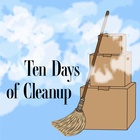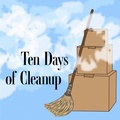Clement of the Japanese American museum called me back an hour later. His hunch was right: the photos and the name plate in the mystery storage unit were connected to this Tokko Kinjo at a retirement home in Boyle Heights. He had even touched base with Tokko’s eldest son, who lived in Alhambra.
“I’m sorry,” Clement said to me over the phone. “The children don’t want you to be interacting with the father, even virtually.”
I let out a sigh. I had ten, no, now nine days, to empty a storage unit in Pasadena. And so far, I hadn’t gotten rid of anything.
“I just need to return these items to their rightful owner. Or else it will just end up in the trash bin.”
From the tone of my voice, Clement knew that I was serious. “The children are open to Zooming with you tonight. There’s four of them—Scott, Cindy, Ellen, and Ralph.”
I was tired of Zoom. Already a big chunk of my day was spent overseeing my daughter Sycamore’s virtual sessions for school, but this was work. If this was the only way I could unload about six by six cubic feet of items, Zoom I would do.
I felt self-conscious that evening as I clicked on the Zoom link and watched my laptop screen connect, a message asking me if I want to continue with computer audio. I was an introvert and Japan-born. Although I had lived in America since high school, sometimes I failed to pick up some American pop culture references, especially if they were pre-2000. Being on a virtual format would not help.
As my image flickered on the screen, I saw the faces of four strangers. They were all Japanese American, and judging from the gray hair and wrinkles on some of them, they must have been in their sixties or older.
Scott, the oldest one, commanded the meeting, but he seemed more protective than curious.
I had taken some photos of the items in the storage unit and Scott allowed me to share my screen to show them to him and his siblings. First was the wood name plate.
The younger sister, Ellen, seemed to be the most familiar with the Japanese language. “Yes, that’s our name in kanji.”
“Are you sure?” the older sister, Cindy, asked.
“Yes, I’m sure. I spent a year in Japan after college, remember,” Ellen snapped back.
“Well, that was a long time ago,” Cindy commented.
I showed a square black-and-white photo of a family standing in front of a barrack.
This time Scott’s voice seemed more invested in the artifacts. “That’s definitely Dad in the glasses on the left. And I think that may be Uncle Hiroshi in the plaid shirt. Baachan and Jiichan, too.”
“I’ve never seen that photo before,” said Cindy.
The youngest Kinjo, Ralph, had been quiet until now. “Let’s get Dad on this call.”
Now the family was changing its tune? We decided to reconvene in thirty minutes. Obviously, these items were of value to the family.
When I joined the second meeting with the Kinjos, an older man with thinning white hair was now in one of the Zoom squares. He blinked self-consciously and angled his ear toward the screen. I could see that he was wearing a hearing aid.
We were introduced to each other, but I had the feeling that Tokko Kinjo had no idea on why I was there on the call.
As the last time, Scott took over the meeting and asked me to share images on the screen. “Dad. Do you recognize this?” he asked about the carved wooden name plate.
“Oh, that’s my last name in Japanese.”
“Do you know what this is?” Cindy asked.
“My dad carved that in camp. We had it outside our barracks.”
“So in Amache, right? Nevada?” Scott said.
“No, no, the camp was in Colorado.” Cindy sounded annoyed.
“Yes, yes. Amache,” the father confirmed.
Scott directed me to go through some of the black-and-white prints.
“All of those are my photos,” Mr. Kinjo said.
“Your photos?” Ellen asked.
“I took most of these photos except the one that I’m in. I dug a dark room underneath my bed.”
“I don’t understand,” said Ralph.
“You weren’t supposed to take photos in camp, although a lot of us were able to sneak in cameras. The challenge was—how to the develop the film. Amache was built over dirt with unreinforced brick on top of it. I just removed the bricks and started digging.”
Apparently Mr. Kinjo dug a hole that was six feet deep for his dark room. He placed a trap door over the hole. It was an amazing story. I felt like I was hearing a spy novel come to life.
“Well, if you guys don’t want the photos and artifacts, I want it,” Ralph spoke up.
“No, I want them,” Ellen said.
“I want some of those photos, too.” Cindy entered the fray.
I didn’t have time to be in the middle of a family squabble.
“The thing is, I need to get rid of this as soon as possible. Can someone meet me at EZ Storage in Pasadena tonight?”
“Tonight? It’s 8 p.m.,” Cindy looked like she might be in her pajamas.
“Oh, I can’t do it tonight,” Ellen said.
“No, tonight is quite impossible. How about later this week?” Scott chimed in. Later this week? I had a whole storage unit to clean out!
Finally, the youngest, Ralph, saved the day. “I live in Glendale. I can pick them up now.”
I couldn’t leave Sycamore at home by herself, so she accompanied me to the storage unit in her pajamas and fuzzy slippers. She actually viewed the outing as exciting; that’s how starved we were to break up our monotonous routines.
Ralph, a thin man with glasses, was already waiting for me at the gate. We made sure that we stood six feet apart from each other as I told him to follow me in his car.
Sycamore was sitting upright in the passenger’s seat, fascinated as I punched in the code in the keypad. She would finally be introduced to what I did for a living.
We parked in front of the unit and I unlocked the gate. I pointed to the items that were part of the Kinjo collection and Scott began to move the items into his trunk and back seat.
“Where is this all from, anyway?” he asked when he was done.
“It’s hard to explain. To tell you the truth, I’m not even sure. My business is to have this unit emptied out by the end of the month.”
“You could have just thrown everything out, right?”
I nodded. I could have. And in terms of what was left over, I still could.
“My father has just been diagnosed with Alzheimer’s. We don’t know how long we will have him around. Or at least his mind.” Ralph’s eyeglasses began to steam up. “For you to gift this piece of his past to us, I can’t tell you what it means to us.”
Even with his mask obscuring most of his face, I could hear his emotion.
“Really,” I said.
When we arrived home, I reopened the box that held my childhood photos from Japan.
“What’s that, Mama?” Sycamore came to my side.
“It’s almost ten. Way after your bedtime.”
Sycamore was still wired from our evening adventure and I felt that I had to give her something as a reward.
I pulled out one of the cream-colored albums that my mother had sent to me and showed her the first page. There I was as a seven-year-old, donning a brilliantly colored kimono. My hair was teased up in a bun and decorated with silk cherry blossom flowers.
“Who’s that?” Sycamore asked.
“That’s me.”
“I’ve never seen you little. You look like a doll.” She didn’t say it sarcastically but earnestly.
“It’s called a shichi-go-san ceremony,” I explained. “It’s held every November.”
Sycamore counted with her hands. “Shichi. Seven. Go. Five. San. Three.”
I was impressed. “That’s right. It’s a special ceremony for girls who are three and seven and boys who are five. All we really do is dress up and take photos.”
“Can I borrow this one for my Zoom show-and-tell tomorrow?”
“Really,” I repeated the same word that I had said to Mr. Kinjo’s youngest son.
“Do you still have this kimono?”
“Well, I’m sure my mother still does back in Japan.”
“Do you think that she can send it over to us?” she said as I gently pushed her toward her bedroom. “Maybe I can do shichi-go-san in November.”
(Note: This fictional installment was inspired by the story of “Jack Muro, the underground photographer of Amache” by Gary T. Ono.)
© 2021 Naomi Hirahara





